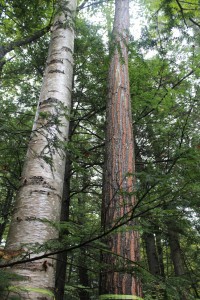
Fragmented networks of protected areas are not sufficient for meeting conservation goals. Private land comprises 80% of Connecticut’s timberland, which implies that private land conservation has a far greater potential for impact than does traditional protected areas management in the context of this land area.
Located within the “Last Green Valley,” the Quiet Corner spans one thousand square miles and contains many rural and semi-rural towns. This initiative will serve as a platform for research, land management, and education in that region.
Since nature’s boundaries do not coincide with property boundaries, it is difficult to collectively manage large landscapes, making it critical to reach out to neighboring landowners. As a result, the Quiet Corner Woodland Partnership (QCWP), the first outreach program enacted by the QCI, offers free land management plans and educational seminars to private landowners throughout the four towns located in the Yale-Myers Forest. About fifteen partners attended the first educational workshop where they learned about the impacts of glaciation and human land-use on the Yale-Myers Forest. Most of them have also agreed to work with the QCWP.

The QCWP is integrated into the curriculum at the School of Forestry and Environmental Studies. Classes focus on natural resource management, environmental issues, and ecological problems. The entire area is a living laboratory, with research projects focusing on methane formation in decaying trees, topographic patterns in seedling recruitment, and evolution of predator-prey interactions across the landscape. Students also utilize satellite data to evaluate land cover and the changes in land use over time.
Additionally, Yale students learn how to create individual management plans, which are primarily forest management plans that outline silvicultural practices for pursuing a variety of goals. For example, students evaluate characteristics such as the social and ecological context, biophysical site characteristics, land-use history, and landowners’ management goals. Students also perform economic analyses on a number of fronts, including determining the value of water quality, carbon sequestration, hunting leases, and timber. In addition to these forest management plans, landowners can request agricultural recommendations, such as guidance on good areas for agricultural development and areas that should be left alone.
Through collaboration and cooperation with the QCI, neighboring landowners have the opportunity to take an active interest in protecting their land. This innovative effort of the Yale School of Forestry and Environmental Studies may set a model for large land trusts to engage other owners of neighboring properties to pursue similar goals. In the words of Aldo Leopold FES 1909, “conservation is a state of harmony between men and land.” The QCI’s recent efforts to advance “big-picture” sustainability goals at the small-scale and site-specific level are steps in the right direction.
